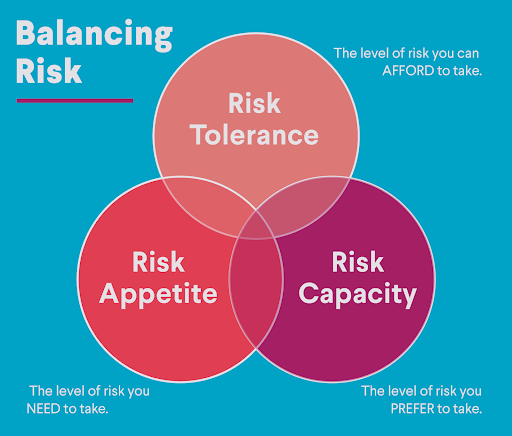What Every New Investor Should Know About Risk
Risk is a critical component of each and every investment, and there are several things about risk, and an individual’s ability to handle it, that investors need to know about. Those include the types of risk involved in investing, the relationship between risk and potential returns, and how to effectively manage it.
Investors should consider their appetite and tolerance for risk, and try to determine which assets are suitable for them. Investing involves understanding the risk profiles of the different assets, among other things, too.
Higher Risk, Higher Potential Return
The most important thing to understand about risk is something you’ve probably heard before: Generally, the higher the risk of your investment, the greater return you should expect on your money. It is, however, the nature of risk that the return you expect might not be the return you actually get.
The concept of “Modern Portfolio Theory” emphasizes that risk and reward are linked. If you hope for a higher return, you should also expect higher volatility — the variability of actual returns. The returns on an exchange-traded fund (ETF) may be up one year and down the next.
Returns on a mutual fund of emerging market stocks will likely have much wider changes in returns from year-to-year, or even month-to-month. You might make a lot more money, but you also could lose much more.
💡 Quick Tip: When people talk about investment risk, they mean the risk of losing money. Some investments are higher risk, some are lower. Be sure to bear this in mind when investing online.
How Much Risk Should You Take?
When determining a level or risk that you’re comfortable with, you want to first look at the goals you have (buying a house, saving for college, and retiring, to name a few), as well as how many years will it be before you need the money for each goal. That’s called a “time horizon.”

Generally speaking, the longer the time horizon, the more risk you can afford to take, because you have more time to recover from market downturns.
This is why young people are advised to put their retirement savings in a more aggressive portfolio. As you get closer to retirement, you’ll generally want to be more conservative. You can also consult a retirement calculator to see where you stand on your retirement goals.
Risk Tolerance Quiz
Take this 9 question quiz to see what your risk tolerance is.
⏲️ Takes 1 minute 30 seconds
What Types of Risk Are There?
There are several types of risk that every investor should be aware of. Here are a few:
• market
• business specific
• price volatility
• interest rate
• concentration
Some risks you can’t avoid, like market risk or beta. The market goes up and down, and this often affects all stocks. Investors can measure the risk in their stock holdings by finding their portfolio’s beta. This will show how sensitive one’s portfolio is to volatility in the market.
You can, however, reduce other risks. For example, if you buy individual stocks, you open yourself up to business specific risk. But, if you buy an index fund, you are buying assets in multiple companies. If one of these companies falters, it will impact the index, but it won’t have the same harsh impact on your investment. This is why seasoned investors tend to emphasize portfolio diversification so much.
How Should You Manage Risk?
On a broad level, how do you use these concepts to manage your investing risk? One method is to utilize different asset allocation strategies to your advantage.
For example, if you wanted to take a particularly low-risk, or conservative position, you could allocate your portfolio to contain more bonds than stocks. Bonds tend to be safer investments than stocks (though it’s important to remember that there’s no such thing as a “safe” investment), and as such, may be less volatile if the market experiences a downturn or correction.
If you still wanted to play it safe but allow for some risk (and potentially bigger returns), you could split your portfolio’s allocation – that could include 50% stocks, 50% bonds, or something along those lines. Further, if you feel like you have a high risk tolerance, you could take an aggressive position, and invest most of, or your entire portfolio in stocks.
💡 Quick Tip: How to manage potential risk factors in a self directed investment account? Doing your research and employing strategies like dollar-cost averaging and diversification may help mitigate financial risk when trading stocks.
Managing Specific Types of Risk
If you want to get more granular, you can try to manage specific types of risk in your portfolio, such as interest rate risk, business-specific risk, etc.
Interest rate risk, for one, has to do with investment values fluctuating due to changing interest rates. This generally involves bond investments, and one way to try and manage it is through diversification, or even by participating in hedge funds — though that can be its own can of worms, so do your research before jumping into hedge funds.
As for business-specific risk? This refers to specific or particular companies or industries. For example, the aerospace industry faces a different set of challenges and risks than the food production industry. So, changes to the Federal Aviation Administration could, as a hypothetical, cause price fluctuation to aerospace stocks, but not other types of stocks. Again, this can largely be solved through diversification.
There are numerous other types of risks, too, and managing them all is difficult, if not impossible, for the typical investor. You can consider consulting a financial professional for further advice, however.
A good course to take? Be honest with yourself. Over time this portfolio is more likely to have a higher return than the other one, but only if you stay invested through the bad times as well as the good. If that isn’t you, no problem — just pick a less risky asset allocation.
The Takeaway
Risk is unavoidable when investing, and as such, it’s important to understand the nature of the risk, avoid taking risks that you can’t afford, and then to take steps to mitigate risk and still reap the benefits. Think about it like driving a car: It’s risky, but you understand that risk and mitigate it by maintaining your car, obeying traffic laws, and buying insurance. The return is that you get where you’re going faster.
There are no guarantees in investing, but you can make an informed choice of the amount of risk you are willing to take and invest intelligently to reach your goals.
Ready to invest in your goals? It’s easy to get started when you open an investment account with SoFi Invest. You can invest in stocks, exchange-traded funds (ETFs), mutual funds, alternative funds, and more. SoFi doesn’t charge commissions, but other fees apply (full fee disclosure here).
SoFi Invest®
INVESTMENTS ARE NOT FDIC INSURED • ARE NOT BANK GUARANTEED • MAY LOSE VALUE
SoFi Invest encompasses two distinct companies, with various products and services offered to investors as described below:
Individual customer accounts may be subject to the terms applicable to one or more of these platforms.
1) Automated Investing and advisory services are provided by SoFi Wealth LLC, an SEC-registered investment adviser (“SoFi Wealth“). Brokerage services are provided to SoFi Wealth LLC by SoFi Securities LLC.
2) Active Investing and brokerage services are provided by SoFi Securities LLC, Member FINRA (www.finra.org)/SIPC(www.sipc.org). Clearing and custody of all securities are provided by APEX Clearing Corporation.
For additional disclosures related to the SoFi Invest platforms described above please visit SoFi.com/legal.
Neither the Investment Advisor Representatives of SoFi Wealth, nor the Registered Representatives of SoFi Securities are compensated for the sale of any product or service sold through any SoFi Invest platform.
Financial Tips & Strategies: The tips provided on this website are of a general nature and do not take into account your specific objectives, financial situation, and needs. You should always consider their appropriateness given your own circumstances.
Disclaimer: The projections or other information regarding the likelihood of various investment outcomes are hypothetical in nature, do not reflect actual investment results, and are not guarantees of future results.
Investment Risk: Diversification can help reduce some investment risk. It cannot guarantee profit, or fully protect in a down market.
Claw Promotion: Customer must fund their Active Invest account with at least $25 within 30 days of opening the account. Probability of customer receiving $1,000 is 0.028%. See full terms and conditions.
SOIN0523031




